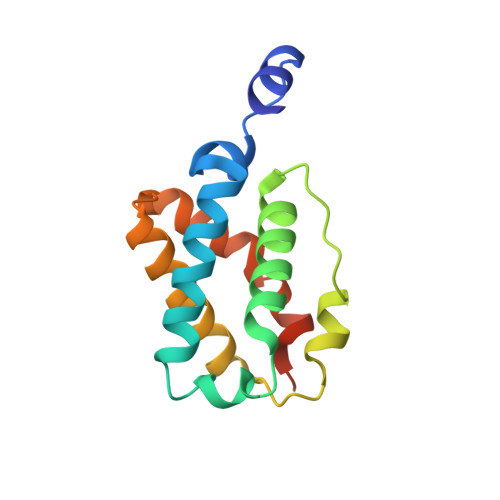Heme-ligand tunneling in group I truncated hemoglobins
Milani, M., Pesce, A., Ouellet, Y., Dewilde, S., Friedman, J., Ascenzi, P., Guertin, M., Bolognesi, M.(2004) J Biol Chem 279: 21520-21525
- PubMed: 15016811
- DOI: https://doi.org/10.1074/jbc.M401320200
- Primary Citation of Related Structures:
1S56, 1S61, 1UVX, 1UVY - PubMed Abstract:
Truncated hemoglobins (trHbs) are small hemoproteins forming a separate cluster within the hemoglobin superfamily; their functional roles in bacteria, plants, and unicellular eukaryotes are marginally understood. Crystallographic investigations have shown that the trHb fold (a two-on-two alpha-helical sandwich related to the globin fold) hosts a protein matrix tunnel system offering a potential path for ligand diffusion to the heme distal site. The tunnel topology is conserved in group I trHbs, although with modulation of its size/structure. Here, we present a crystallographic investigation on trHbs from Mycobacterium tuberculosis, Chlamydomonas eugametos, and Paramecium caudatum, showing that treatment of trHb crystals under xenon pressure leads to binding of xenon atoms at specific (conserved) sites along the protein matrix tunnel. The crystallographic results are in keeping with data from molecular dynamics simulations, where a dioxygen molecule is left free to diffuse within the protein matrix. Modulation of xenon binding over four main sites is related to the structural properties of the tunnel system in the three trHbs and may be connected to their functional roles. In a parallel crystallographic investigation on M. tuberculosis trHbN, we show that butyl isocyanide also binds within the apolar tunnel, in excellent agreement with concepts derived from the xenon binding experiments. These results, together with recent data on atypical CO rebinding kinetics to group I trHbs, underline the potential role of the tunnel system in supporting diffusion, but also accumulation in multiple copies, of low polarity ligands/molecules within group I trHbs.
Organizational Affiliation:
Giannina Gaslini Institute, Largo G. Gaslini, 5. 16147 Genoa, Italy.




















